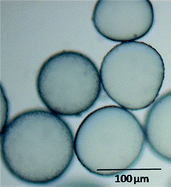Preparation of particle-stabilized emulsions using membraneemulsification†
Abstract
There is currently significant interest in particle-stabilized emulsions for a variety of applications and as precursors to other materials such as microcapsules or colloidosomes. A prerequisite for many applications is the ability to produce stable droplets with a well-controlled size. The preparation of oil-in-


 Please wait while we load your content...
Please wait while we load your content...